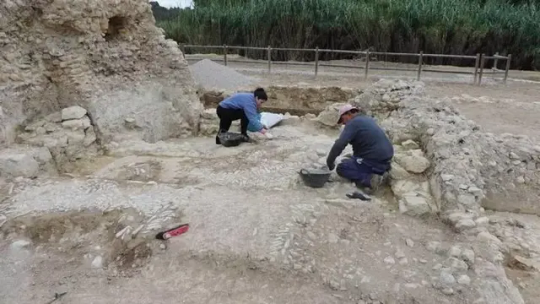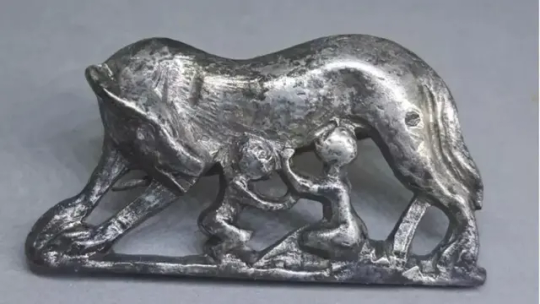#Ancient Roman Silver Brooch of Romulus and Remus Found in Spain
Explore tagged Tumblr posts
Text

Ancient Roman Silver Brooch of Romulus and Remus Found in Spain
The Department of Culture of the Generalitat Valenciana has recently announced the discovery of a rare silver brooch, depicting the iconic scene of Romulus and Remus being suckled by a she-wolf.
This remarkable artifact was discovered during excavations at Vilanova d’Alcolea, a site in Spain believed to have served as an ancient postal building during the Roman era. Archaeologists, led by Josep Carbó, made the discovery, describing it as an exceptional piece both for its rarity and quality.
Romulus and Remus, pivotal figures in Roman mythology, were twin brothers whose legendary tale forms the foundation myth of Rome and the Roman Kingdom. Born in Alba Longa to Rhea Silvia, the twins were the grandsons of the deposed King Numitor. Threatened by their potential claim to power, King Amulius, Numitor’s brother, ordered the infants to be abandoned on the banks of the Tiber River.
Legend has it that the twins were saved by a she-wolf who nursed them in a cave known as Lupercal, situated at the southwestern foot of the Palatine Hill in Rome. Upon discovering their true heritage, Romulus and Remus avenged their family and reinstated their grandfather, Numitor, as the rightful king. However, their story took a tragic turn when a dispute arose between the brothers, leading to Romulus committing fratricide against Remus. Romulus then went on to establish the city of Rome, solidifying his position as its first ruler.

The silver brooch, measuring 4 centimeters in size and dating back to the 2nd century CE, portrays the iconic scene of the she-wolf nurturing the twins in their infancy. This depiction has become synonymous with the founding of Rome since the 3rd century BCE.
The archaeological site where the brooch was discovered holds additional significance. Situated near the Via Augusta, the longest Roman road in Roman Hispania, the site is believed to have been an official post of the Roman Empire, catering to officials and travelers alike. The proximity to this historic route enhances the importance of the find.
Archaeologist, Josep Carbó, emphasized the significance of the discovery, stating, “It is an exceptional piece due to its rarity and quality since there are very few pieces of this type that have been studied.”
By Dario Radley.

#Ancient Roman Silver Brooch of Romulus and Remus Found in Spain#Vilanova d’Alcolea#Via Augusta#silber#silver jewelry#ancient jewelry#ancient artifacts#archeology#archeolgst#history#history news#ancient history#ancient culture#ancient civilizations#roman history#roman empire#roman art#art#ancient art
285 notes
·
View notes
Text
The Daily Tulip
The Daily Tulip – Archeological News From Around The World
Friday 31st August 2018
Good Morning Gentle Reader…. I have always been fascinated by what Archeologists discover laying in the dirt beneath our feet, but, I am even more fascinated by what we humans leave behind, in the case of the Romans for example, they even left a villa behind when they left, now I have to admit, I have forgotten some things, glasses, key’s even a suitcase, but a villa?.. still their forgetfulness is our gain, and we can learn a lot from what they forgot… so I hope you enjoy what I have discovered this Friday morning, enjoy your day…
LARGE ROMAN VILLA UNCOVERED IN OXFORDSHIRE ENGLAND…. BANBURY, ENGLAND—A metal detectorist has teamed up with archaeologists from Oxford Archaeology to uncover a Roman villa dating to around A.D. 99, which measures 278 feet square, and may have been as large as Buckingham Palace, Metro reports. The team believes the site may reveal one of the grandest Roman villas ever discovered in Britain. They have identified the building's bath complex, including tile from a hypocaust used to pipe in hot water, as well as evidence of a domed roof, a dining room, and kitchen areas. Artifacts unearthed include a coin depicting the mythological twins Romulus and Remus. Detectorist Keith Westcott says he was inspired to look for villa foundations in the area after learning that a local farmer had accidently plowed into the burial of a high-status woman, who is believed to have died in the third or fourth century A.D. Plans for comprehensive investigations at the site, possibly involving English Heritage and nearby universities, are under consideration.
COLD SPELLS MAY HAVE DOOMED NEANDERTHALS…. COLOGNE, GERMANY—According to an Associated Press report, a new study suggests that periods of cold, dry climate may have helped modern humans displace Neanderthals from Europe. Neanderthals died out around 40,000 years ago, just a few thousand years after Homo sapiens arrived in Europe. Scientists have proposed a number of explanations, including an epidemic that targeted Neanderthals and competition for scarce resources. The new study draws on previously available data along with new findings on the ancient climate from two caves in Romania. It focuses on two cold, dry periods: One beginning around 44,000 years ago and lasting 1,000 years, and another beginning around 40,800 years ago and lasting 600 years. Both climate events coincided with the disappearance of Neanderthal artifacts and the appearance of signs of modern humans in sites in the Danube River valley and France. Climate shift would have likely replaced forest with shrub-filled grassland, to which modern humans may have been better adapted than Neanderthals. “Whether they moved or died out, we can’t tell,” said Michael Staubwasser of the University of Cologne in Germany.
CAPE COD DIG REVEALS 17TH-CENTURY SETTLEMENT…. CHATHAM, MASSACHUSETTS—Wicked Local reports that archaeologists are excavating what they believe is the site of a seventeenth-century homestead on Cape Cod's southeastern tip. The site dates to 1656 and was once home to English settlers William and Anne Nickerson, who are considered the founders of Chatham. The team, directed by Craig Chartier of the Plymouth Archaeological Rediscovery Project, has uncovered a number of seventeenth-century artifacts on land adjacent to the town's 1829 Caleb Nickerson Homestead, including Native American and European ceramics, pipe fragments, window glass, pieces of flint, and what Chartier believes is a fragment from a sharpening wheel. Perhaps most importantly, they have also identified one of the building's hearths, which, along with postholes and foundation remains can help determine the orientation and footprint of the original structure. According to Chartier, the house was at least 36 feet long by 18 feet wide and might have even been larger. He now plans to excavate more of the property to determine whether it also included a cellar, barn, or other outbuildings.
EARLY ROMAN SETTLEMENT DISCOVERED IN YORKSHIRE…. YORK, ENGLAND—Silver coins dating back 2,000 years that were unearthed by metal detectorists in 2015 have led archaeologists to one of the earliest Roman settlements in northern Britain, according to a report in The Guardian. “All the coins date back to the time of the emperor Vespasian [A.D. 69-79], when the Romans marched north and established a center at York,” says project manager Lisa Westcott Wilkins. The team has uncovered evidence that the settlement was the home of high-status families, including more silver coins, decorated ceramic bowls and amphoras that would have held imported wine, as well as an infant buried with a small brooch. They also identified postholes, foundation trenches, and the possible remnants of one or two villas. The location of the site is currently being withheld to protect it from looters. “We have many settlements from later periods—3rd and 4th centuries—but this one is much earlier and much higher status,” Wilkins says. “This is why it is so rare.”
VIKING TOWN WAS AN IMMIGRANT MECCA…. STOCKHOLM, SWEDEN—Analysis of human remains from the Viking town of Sigtuna dating to the tenth to twelfth century finds that at least half the population consisted of immigrants, according to a report in The Local. Researchers from Stockholm University studied DNA and strontium isotopes from the remains of 38 people to determine where they originated. They found that around half came from the nearby Lake Mälaren area, but the other half came from areas as far off as Ukraine and the British Isles. The evidence suggests that Sigtuna was the Viking Age equivalent of London or Shanghai today, says Anders Götherström of Stockholm University, a place that attracted ambitious people interested in working their way up in the world. Sigtuna was one of Sweden’s first cities, founded in 980, and soon reached a population of 10,000, roughly the same as London at the time. Maja Krzewinska of Stockholm University points out that the Vikings are generally thought of as travelers and adventurers, but the new findings suggest they also played host to those who came from afar.
ANCIENT KANGAROO FEAST FOUND IN AUSTRALIA…. PILBARA REGION, AUSTRALIA—According to an Australian Broadcasting Corporation report, a cave in northwestern Australia has yielded evidence of a campfire and kangaroo feast that may date back 20,000 years. Charcoal from the fire pit will be radiocarbon dated to confirm its age. Stone tools and flakes found near the charcoal may have been used to butcher the kangaroo. “We’ll have to have a look at them under the microscope, but they are the pieces that people were using at the site,” said Michael Slack of Scarp Archaeology. Traditional land owner Garren Smith said stories about the cave have been passed down through the generations. “It’s good that they are doing this and getting the records, having a look at how old things are,” he said.
Well Gentle Reader I hope you enjoyed our look at the archeological news from around the world this, morning… …
Our Tulips today are so beautiful…..

A Sincere Thank You for your company and Thank You for your likes and comments I love them and always try to reply, so please keep them coming, it's always good fun, As is my custom, I will go and get myself another mug of "Colombian" Coffee and wish you a safe Friday 31st August 2018 from my home on the southern coast of Spain, where the blue waters of the Alboran Sea washes the coast of Africa and Europe and the smell of the night blooming Jasmine and Honeysuckle fills the air…and a crazy old guy and his dog Bella go out for a walk at 4:00 am…on the streets of Estepona…
All good stuff....But remember it’s a dangerous world we live in
Be safe out there…
Robert McAngus #Archeology #History #Spain #News
0 notes